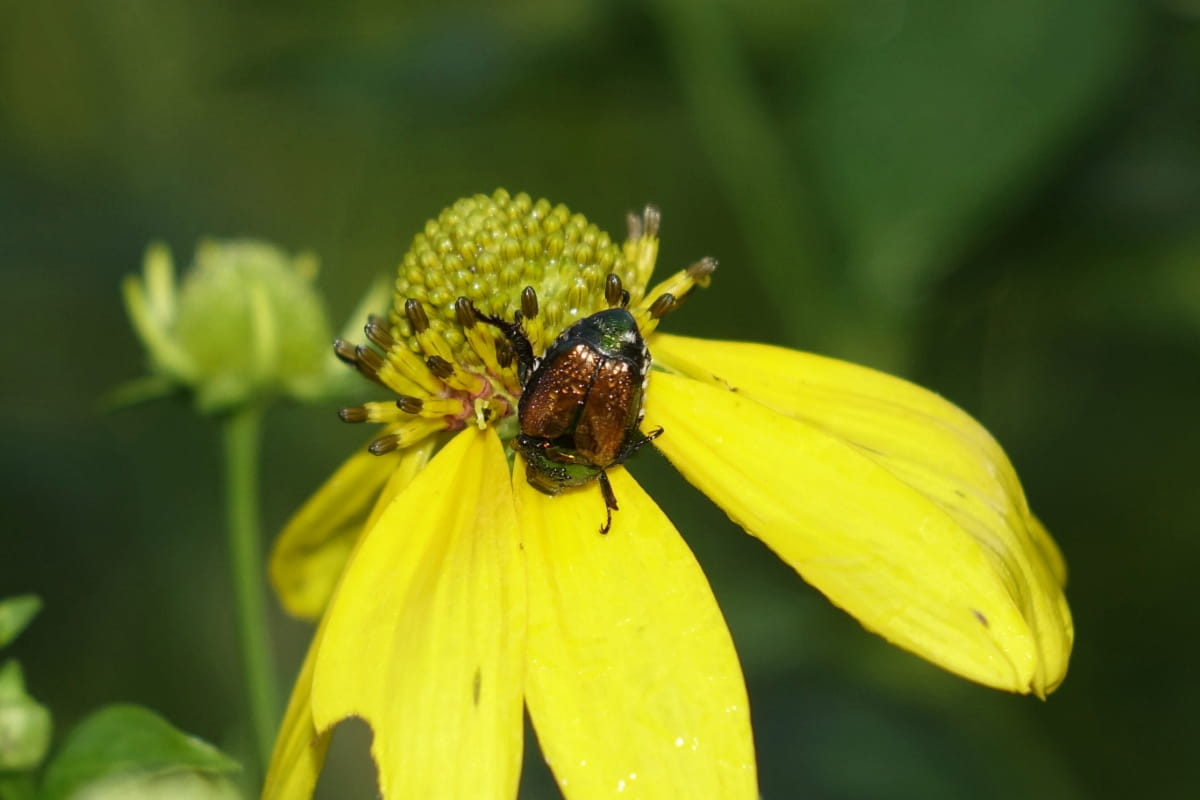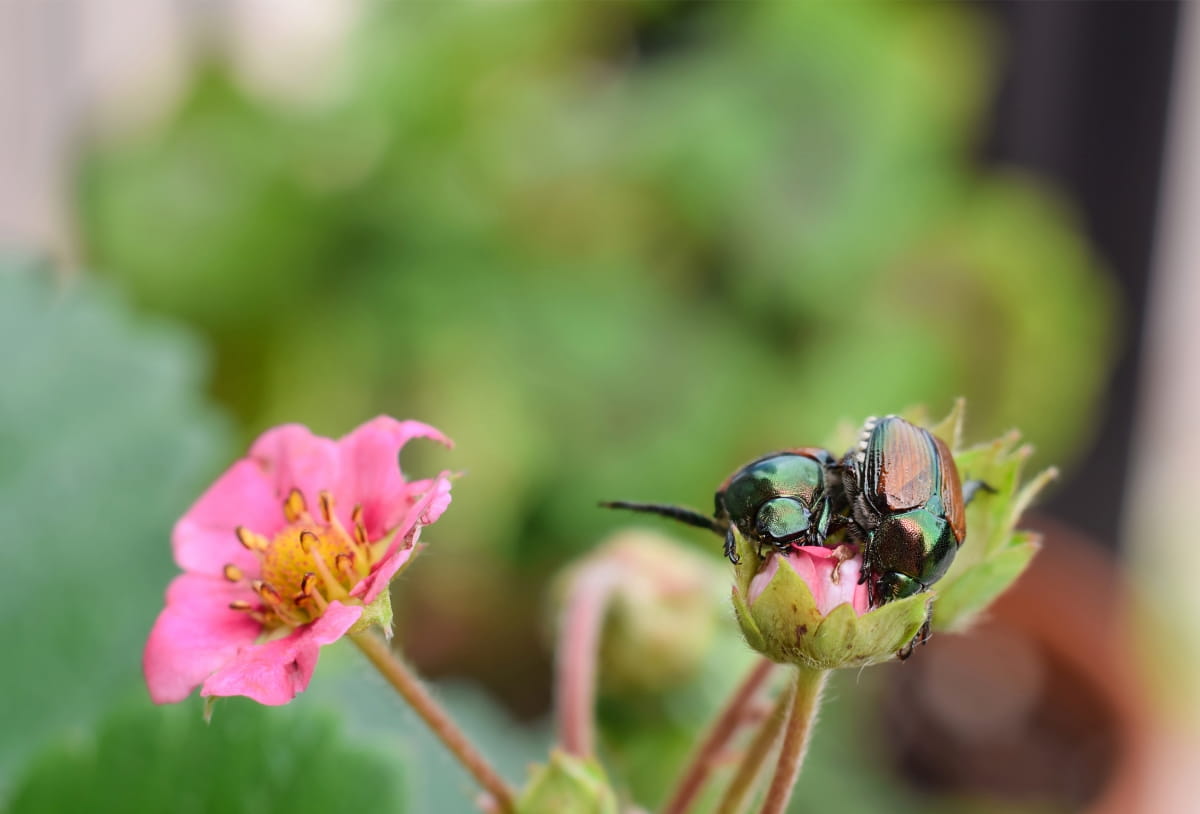Japanese beetles can wreak havoc on your garden, feeding on various plants’ leaves, flowers, and fruits. They can cause accountable damage and even kill your beloved plants if left uncontrolled. Fortunately, you can employ several organic and natural methods to prevent and control Japanese beetle infestation in your garden. In this document, we will explore these methods and provide you with effective ways to eliminate these troublesome pests.

How to Control Japanese Beetles in Your Garden
Milky Spore Powder
Milky Spore is caused by a bacterium called Bacillus Popilliae. Despite its harmlessness to humans, pets, and wildlife, it causes havoc among Japanese beetle larvae. In the soil around the Japanese beetle larvae, new spores are released when they eat spores of Milky Spore. For 20 years, the spores remain in the soil, killing Japanese beetle larvae.
Hand Pick
- If it is early in the season and you just see a few bugs, you can handpick them right from your plants.
- Drop them in soapy water to kill them.
- Remember that beetles are most active on warm days when the air is still. The best time to handpick is in the early morning or later evening.
Organic Solutions for Japanese Beetle Infestation
Cedar Oil
- Place 3 one foot long red cedar plants in a two-gallon bucket. Pour hot water on top of the plants and let them sit for 24 hours.
- Be sure that the planks are completely covered.
- You can cut them if you have to. Fill this liquid into a spray bottle and spray your plants liberally.
Diatomaceous Earth
When killing Japanese beetles, diatomaceous earth (DE) is a good choice. This white powder is made from the fossilized remains of very tiny aquatic organisms. Sprinkle DE in the soil around your plants and the foliage wherever you see beetles. The powder gets under the shells and dehydrates the beetle. This method also works great on ants, snails, and slugs.
Preventing Japanese Beetles in Your Garden
Beneficial nematodes go after the larvae and may help keep populations of Japanese beetles as well as several other pests down. Nematodes are most effective when added to your soil in late summer and early fall, which will lower populations the following year. However, nematodes can be added to the soil anytime if you keep your soil watered. This package of nematodes has three varieties to combat several pests. This one is only H. bacteriophora, the variety that goes after Japanese beetles (cutworms and cucumber beetles).
Effective Ways to Eliminate Japanese Beetles
Insecticidal Soap: Insecticidal soap is another great way to control Japanese beetles. Mix one tablespoon of mild insecticidal liquid soap with one liter of water. The soap will kill some of them on contact, and the rest will be stunned and easier to handpick. The best time of day to spray Japanese beetles is in the morning or evening when they aren’t as active. Don’t spray plants in the middle of the day because the hot sun could cause damage.
Safe and Non-toxic Remedies for Japanese Beetle Control
Neem Oil: Neem oil is the pressed oil of the neem tree’s seeds and is often used in organic pest control and body care products. Neem interferes with beetles’ reproductive cycle, preventing eggs from hatching more beetles. Together with drowning adults, a neem spray should help reduce Japanese beetle populations if used every few days.
Grow Plants that Repel Japanese Beetles
Unfortunately, Japanese beetles are like some of the plants we most value in our gardens, including beans, plums, apple trees, and grapevines. They are also partial to roses, hibiscus, maple, linden, and birch. Choosing plants that repel these pests may help keep them away from plants you want to protect. Some options to consider:
- Catnip
- Chives
- Garlic
- Larkspur
- Leeks
- Marigold
- Onion
Managing Japanese Beetle Damage in Your Yard
One of the most effective ways to manage Japanese beetle damage is by utilizing physical barriers. Consider installing fine mesh netting over vulnerable plants and trees to prevent adult beetles from feeding on them. This method can be particularly useful for protecting fruit trees, roses, and other high-value plants.
In case you missed it: Management of Flea Beetles in the Vegetable Garden: Prevention, Control, and Treatment

Encouraging natural predators of Japanese beetles can also help manage their population. Birds, such as robins and starlings, feed on beetles, so providing birdhouses or bird feeders can attract these helpful creatures to your yard. Planting flowers that attract beneficial insects, like ladybugs and lacewings, can also create a more balanced ecosystem and reduce Japanese beetle numbers.
Controlling Japanese Beetles Without Pesticides
Pheromone Traps: Pheromone traps are another great option for controlling Japanese beetles without spraying harmful pesticides. They are completely non-toxic and harmless to other bugs. The traps attract the adults with pheromones and other scents they can’t resist. They fly into the trap but can’t get back out.
Use Row Covers: A row cover might be the best solution to stop a Japanese beetle infestation before it starts. Row covers protect by keeping Japanese beetles out but are still fine enough to let in light and some moisture, allowing the plants to grow. Row covers are best used during peak feeding periods for the beetles, which generally run from mid-June to mid-August.
Tips for Eradicating Japanese Beetles From Your Plants
Milky Spore Disease: Milky spore disease is a natural bacterium that affects the Japanese beetle larvae living in the soil. Applying milky spore powder to your lawn or garden can help control the population of Japanese beetles over time.
Plant Resistant Varieties: Another approach to dealing with Japanese beetles is to plant varieties that are less attractive to them. Research and choose plants that are known to be resistant to these pests. This can minimize the damage caused by Japanese beetles in your garden.
Companion Planting: Certain plants can repel Japanese beetles when grown alongside susceptible plants. For example, planting garlic, chives, or marigolds near vulnerable plants can deter the beetles due to their strong smell. Consider incorporating these companion plants into your garden layout.
Proven Strategies to Combat the Japanese Beetle Invasion
Monitoring and Early Detection: Regular monitoring of susceptible areas can help identify the presence of Japanese beetles at an early stage. This can be done through visual inspections or by using pheromone traps specifically designed to attract these beetles. Early detection allows for prompt action to prevent further infestation.
Cultural Practices: proper pruning, maintaining healthy soil conditions, and removing decaying organic matter that can serve as breeding grounds for the beetles. Additionally, rotating crops and diversifying plantings can disrupt the beetle’s life cycle and prevent a buildup of its population.
Biological Control: Introducing natural predators and parasites of Japanese beetles can help control their population. For example, the parasitic wasp, Tiphia vernalis, lays its eggs inside the beetle’s larvae, preventing them from developing into adults. Similarly, nematodes can be applied to the soil to target the beetle larvae. These biological controls can be an environmentally friendly and sustainable approach to combat the invasion.
In case you missed it: Japanese Gardening Design: Principles, Elements, and History

Conclusion
Japanese beetles can be a nuisance in the garden, but with the right organic and natural methods, you can prevent and control their infestation. By implementing these methods, you can enjoy a beautiful and pest-free garden.
- Feed Your Flock for Less: Top 10 Tips to Save on Chicken Feed
- Ultimate Guide to Ossabaw Island Hog: Breeding, Raising, Diet, and Care
- Hatching Answers: The Top 10 Reasons Your Chickens Aren’t Laying Eggs
- Eggs and Economics: Breaking Down the Cost of Raising Backyard Chickens
- Defend Your Greens: Proven Methods to Keep Iguanas Out of Your Garden
- Ultimate Guide to Cinnamon Queen Chicken: A Comprehensive Guide for Beginners
- Ultimate Guide to California Tan Chicken: Breeding, Raising, Diet, Egg-Production and Care
- Ultimate Guide to Marsh Daisy Chicken: Breeding, Raising, Diet, and Care
- 10 Types of Chicken Farming Businesses You Can Start for Profits